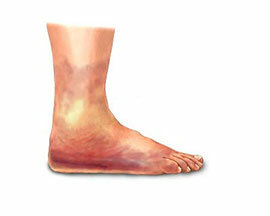Usually, thrombophlebitis begins to develop with varicose veins. In most cases, thrombophlebitis of superficial veins of the lower extremities is formed. This disease can begin, due to complications caused by an infectious disease or may be an inflammatory process in the wound on the shell of the vessel. Sometimes thrombophlebitis can result from complications after childbirth.
The newly formed thrombus can:
- block the lumen of the vessel, disrupting the circulation;
- break away from the vessel wall and is transported by the flow of blood to other organs;
- can simply resolve.
There are phlebitis( inflammation of the vessel walls without thrombus formation) and thrombophlebitis, in the formation of which lies a whole complex of causes:
- infection;
- weakening of blood flow;
- decreased body reactivity;
- increase in blood clotting;
- changes in blood composition;
- destruction of the integrity of the shells of blood vessels.
Thrombophlebitis occurs:
- acute;
- chronic;
- subacute.
By the nature of the development of the disease, thrombophlebitis of superficial veins can be purulent and non-purulent.
Symptoms of thrombophlebitis of superficial veins can be expressed in:
- gastrocnemius pain;
- pain arising when pressing with hands;
- swelling on the legs and under the eyes;
- is red.
Symptoms depend on the form of the disease and the place of formation of the thrombus. The patient's body temperature can rise above thirty-eight degrees. The skin of the foot becomes blue. After forty-eight hours, the lower half of the body begins to become covered with a network of swollen veins. The patient experiences strong weakness, he does not want to move at all. There are symptoms of self-regulation of the body, the patient is constantly fever.
Thrombophlebitis of superficial veins of the upper limbs is much less common.
The reasons for its formation may be:
- catheterization;
- intravenous injection;
- continued medication infusion;
- injury;
- purulent foci.
The condition of the patients is most often satisfactory, only sometimes cellulite or melting of the blood clot is possible, accompanied by purulent discharge.
Acute thrombophlebitis of superficial veins in case of complications of the disease can be raised through the subcutaneous veins before the inguinal junction( ascending thrombophlebitis).
An exceptional severity of the disease is noted with septic purulent thrombophlebitis. In this case complications are possible:
- sepsis;
- metastatic abscess;
- phlegmon limb.
It is not difficult to diagnose veins: it is enough to conduct a duplex study. As a result of scanning, the true thrombus boundary is revealed, which may not coincide with the boundaries established by palpary.
Deep vein thrombophlebitis is a more serious and dangerous disease than thrombophlebitis of superficial veins. Despite the fact that both of these diseases are very similar, they are easily distinguished and prescribe a timely treatment. Thrombophlebitis of deep veins begins, as a rule, with prolonged periods of immobility and is accompanied by disorders of blood coagulability.
Thrombophlebitis of superficial veins of the penis occurs due to dyssal vein dysfunction. In this disease, the bed rest and elevated position of the pelvic region are prescribed. It is necessary to conduct short-term walks, during which it is necessary to fix the penis with an elastic bandage. Bandaging maximizes the retention of a thrombus. Locally apply ice, perform anti-inflammatory therapy, with the use of acetylsalicylic acid, rheopyrin, phenylbutazone.
Treatment of thrombophlebitis of superficial veins is carried out individually for each case. For example, with the formation of thrombophlebitis in the shin area, it is possible to conduct outpatient treatment. The basis of treatment is the use of an elastic bandage, which is located ten centimeters above the border of the thrombus.
Of the drugs are used:
- phlebotonics;
- anti-inflammatory drugs;
- ointment;
- gels;
- solution of heparin and hydrocortisone.
In case of transition of inflammation to the thigh, the patient needs urgent hospitalization, as the thrombus moves along the vein at a speed of about twenty centimeters per day. With the spread of thrombosis on the thigh - a mandatory operation is indicated, consisting in the removal or bandaging of the affected veins.
In any method of treatment, when the affected veins remain in place, the thrombus resolves itself or there is fibrosis( complete overlap of the venous canal).Fibrosis is more preferable, but its occurrence does not happen so often.
 Thrombophlebitis is an inflammatory process of the venous wall with the formation of a thrombus that blocks the lumen of the vessel.
Thrombophlebitis is an inflammatory process of the venous wall with the formation of a thrombus that blocks the lumen of the vessel.



